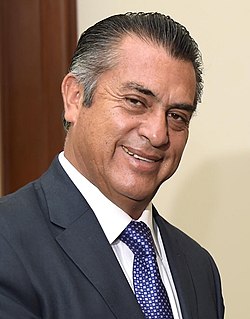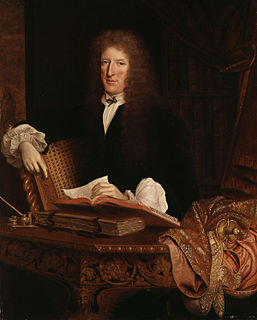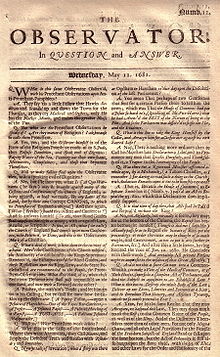
The Mexican state of Nuevo León has been governed by more than a hundred individuals in its history, who have had various titles and degrees of responsibility depending on the prevailing political regime of the time.
Samuel Pordage was a 17th-century English poet. He is best known by his Azaria and Hushai (1682), a reply to John Dryden's Absalom and Achitophel.

Sir Roger L'Estrange was an English pamphleteer, author and staunch defender of Royalist claims. L'Estrange was involved in political controversy throughout his life. Perhaps his best known polemical pamphlet was An Account of the Growth of Knavery, which ruthlessly attacked the parliamentary opposition, placing them as "dissenting fanatics" and truly beyond the pale.
This is a list of people who have served as lord lieutenant for Staffordshire. Since 1828, all lord lieutenants have also been custos rotulorum of Staffordshire.

The Académie Royale d'Architecture, founded in 1671, was a French learned society, which had a leading role in influencing architectural theory and education, not only in France, but throughout Europe and the Americas from the late 17th century to the mid-20th.
Giovanni Battista Bassani was an Italian composer, violinist, and organist.

The Sampling Officials, also called Syndics of the Drapers’ Guild, is a 1662 oil painting by Rembrandt. It is currently owned by the Rijksmuseum in Amsterdam. It has been described as his "last great collective portrait".
Angelo Berardi was an Italian music theorist and composer.
Hamon L'Estrange was an English writer on history, theology and liturgy, of Calvinist views, loyal both to Charles I and the Church of England. Along with Edward Stephens, he contributed to the seventeenth-century revival of interest in ancient liturgies; with John Cosin and Anthony Sparrow he began the genre of commentary on the Book of Common Prayer. He has been confused at times with his father, son and grandson of the same name.
Luke de Beaulieu was a Huguenot exile and cleric in England.

Sir Thomas Dolman was an English landowner and politician who sat in the House of Commons from 1661 to 1679.

John Balderston was an academic at the University of Cambridge in the 17th and 18th centuries.
Giovanni Maria Pagliardi (1637–1702) was an Italian composer. He became de facto maestro di cappella at Florence Cathedral from 1690, but did not formally gain the title till the death of his predecessor, Pietro Sammartini.
Seth Ward was an Anglican priest: the Archdeacon of Wilts from 1675 until 1687.
Thomas Ward was an Anglican priest: the Archdeacon of Wilts from 1687 until his death.
Gian Domenico Partenio was a Venetian composer of operas during the Baroque period. He served as vice maestro of St Mark's Basilica's Cappella Marciana from 1685, before succeeding Giovanni Battista Volpe as maestro di cappella from 1692 until 1701.






